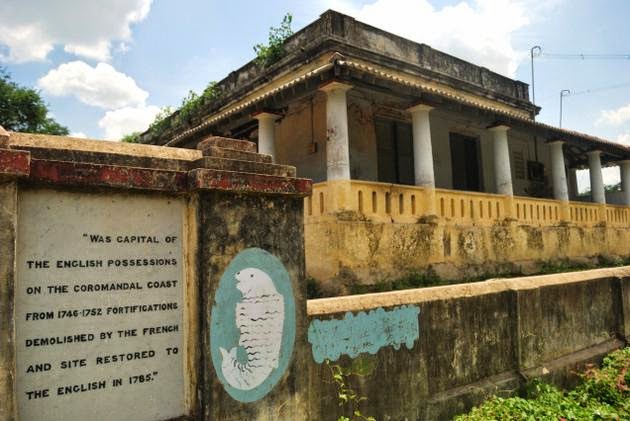Europeans started establishing their
business settlements in Indian coast ever since 17th century. In the eastern
coast French established their business settlements in Pondicherry and British
established their settelements and business establishments in Cuddalore. Later
British started ruling the region and they built several forts.Fort St.David
was the first fort built by British. Robert Clive, who laid a strong foundation
for British rule in Indian subcontinent, used St.David Fort as the centre for
his military operations.
Fort St.David: Fort St.David was built
in 1653 A.D. by Elihu Yale. The fort was strengthened on 1693,
1698,1702,1725,1740 and on 1745. Until 1758 Cuddalore was the capital to South
Indian terrioties which was under British control then. British ruled a greater
part of South India (entire Tamil Nadu, parts of present Andra Pradesh, Kerala
and Karnataka) from this fort (St.David). The fort was attacked by French in
1758.It was after this attack St.David Fort lost its political importance. The
operational power was shifted to Fort St.George, Madras. Even today the post
office in Devanampattinam (popularly known as Silver Beach) uses the
rubberstamp with Ft. St.David embossed in it.
Garden House: The present official
residence of Cuddalore District Collector was then known as Garden House. It
was then the residence of Robert Clive. The roof of the Garden House was built
without steel and wood. It was built using only bricks and slaked lime. It
bears testimony of the later medieval architecture. St.David fort was also
built using the same ingredients and techniques. The large vacant space next to Garden
House which now knows Chevalier Shivaji Arangam or Manajai Nagar Ground was an
esplanade then. British used to have esplanades near their fortresses.
Brookes Pet: Brookes Pet is half a
kilometer from present Vandipalayam.It was named after Henry Brookes who ruled
between 1767 and 1769.
Cumming Pet: The area to north of
Thriupathiripuliyur is known as Cumming Pet.It was named after William Cumming
who ruled the region from 1778.Cumming Pet was once a place meant for
washermen.On 1798 Tipu Sultan-The King of Mysore invaded Cumming Pet and the
settelements there cleared on the invasion.
Cuddalore Old Town (O.T.) Present day
Cuddalore O.T. was known as Islamabad during the Mughal period. Even today the
majority of the people in Cuddalore O.T. follow Islam. Cuddalore O.T. has one
of the oldest and biggest mosques in South India. The mosque and most of the
houses there (still) were built in Persian style. Until 1866 District
Collectorate, Cuddalore Municipal Office and other administrative offices were
in present Cuddalore O.T.In 1866 all these offices were shifted to Manjai
Nagar.It was only after the shift in 1866 the term Cuddalore OT and Cuddalore
NT (NewTown) came into existance.Still there are several streets and localities
named after popular British rulers. Clive Street, Wellington Street is some to
name.
Gadilam Castle: Nawab Umdat-ul-Umara
built Gadilam Castle in 18th century. Gadilam Castle was located to the North
of Gadilam River. It was built exactly in the place where the present
Brindhavan Hotel is located.
Capper Hills: Capper Hills was named
after Francis Capper who was the Captain till 1796.He resided in a palace in
there. British buit a prison in the Capper Hills. Freedom fighters like
Barathiar and other prisoners of war were imprisoned there.
British educational intuition: In 1717
St.David school was started in Cuddalore O.T. to educate the children of East
India Company.On 1886 a college was started in its premises. The college was
named after St.Joseph.It is one of the earliest schools in India which follows
Western education system. Roads named after British like Napier Road, Lawrence
Road, Imperial Road and streets like Clive street, Wellington street, business
establishments like Panpari market and Parry's House remains a reminder of the
British rule here.




No comments:
Post a Comment